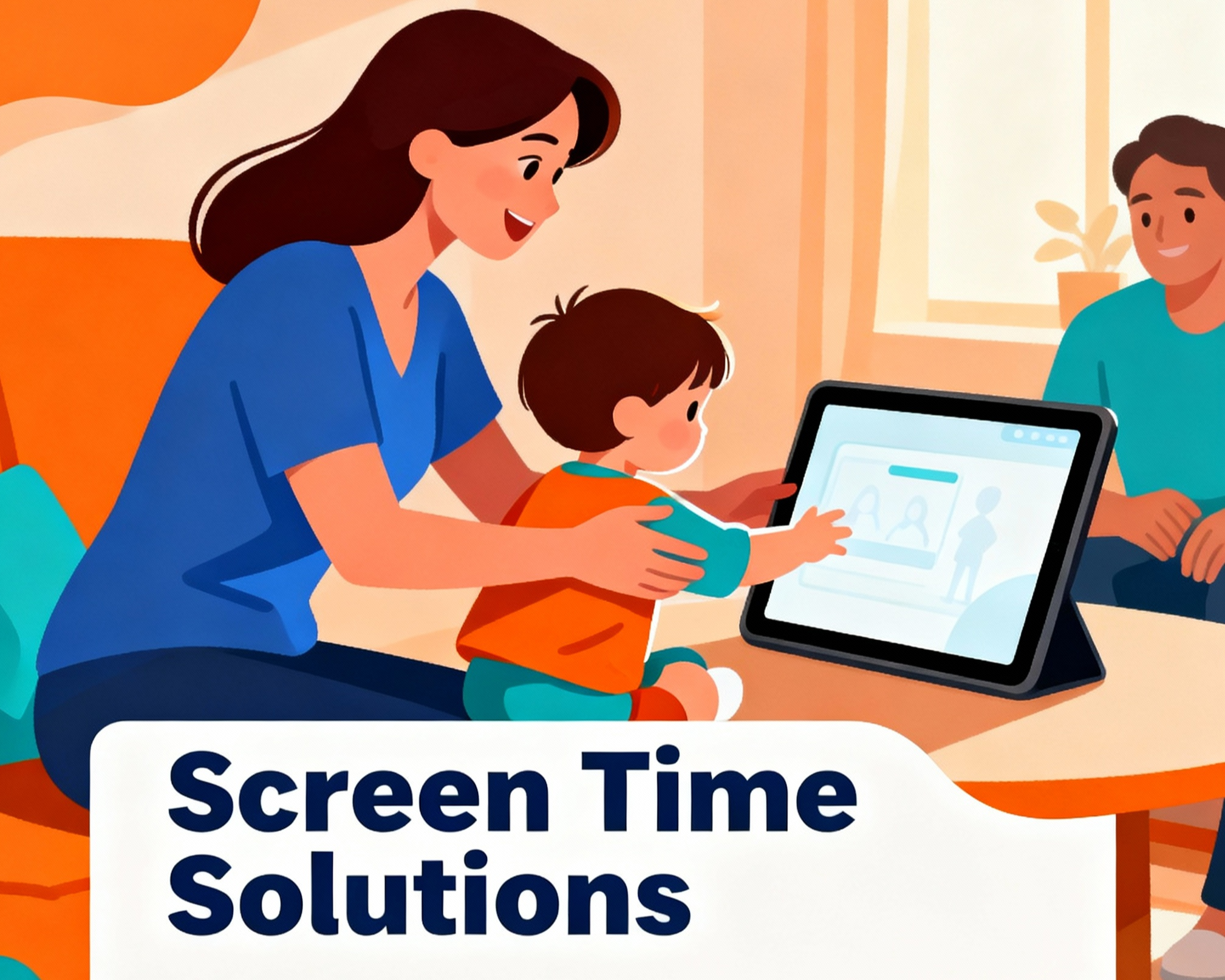Screen Time Crisis: Cut 7-Hour Daily Average in 30 Days

Kids average 7 hours daily screen time in 2025—increasing addiction risk 3x. Proven 30-day plan to reduce digital use 50%, improve sleep, boost focus. AAP guidelines
Is your child glued to screens for 7+ hours a day?
In 2025, children average 7 hours of daily screen time—double the 2020 average—leading to addiction symptoms, poor sleep, declining grades, and family conflict.
But here’s the breakthrough:
Families using structured media plans reduce screen time by 50% within 30 days, dramatically improving sleep quality, academic performance, and parent-child connection.
This guide provides the exact research-backed strategies that work—no battles, no guilt, just proven results.
Screen Time Solutions: Reduce the 7-Hour Daily Average
Kids now average 7 HOURS of screen time per day. Learn research-backed strategies to set healthy boundaries, reduce digital addiction, and boost your child’s mental health. AAP guidelines + proven family media plans.
📊 Is Your Child’s Screen Time Healthy?
Take this 3-minute assessment based on AAP 2025 guidelines
The Screen Time Crisis: What Parents Need to Know
Last Updated: October 2025 | Recent research from The Journal of Child Development reveals that children in 2025 are averaging 7 hours of screen time per day, contributing to heightened risks of technology addiction, poor mental health, and developmental delays. This represents a 40% increase from 2020 levels.
According to the American Academy of Pediatrics (AAP) 2025 guidelines, 80% of families experience improved communication and quality time when adopting structured family media plans. One family successfully reduced screen time by 50% within a single month, resulting in better sleep, improved grades, and more meaningful family connections.
🚨 Warning Signs of Screen Time Overload:
- Technology addiction symptoms: Irritability when devices are taken away, sneaking screen time
- Mental health impacts: Increased anxiety, depression, low self-esteem from social media comparison
- Physical health decline: Obesity (40% correlation), poor sleep quality, eye strain, headaches
- Social skills deterioration: Difficulty with face-to-face conversation, reduced empathy
- Academic performance drop: Decreased attention span, lower grades, inability to focus
- Family disconnection: Less dinner conversation, reduced quality time, parent-child conflicts
🧠 The Science Behind Screen Time Damage
Research from Stanford University (2024) found that excessive screen time in children ages 0-5 causes measurable changes in brain structure—specifically thinning of the cortex responsible for critical thinking and language development. fMRI scans show that screen addiction activates the same brain regions as substance addiction.
The most concerning finding: Children with 7+ hours daily screen time showed 2 standard deviations lower scores on cognitive and language assessments compared to peers with <1 hour daily exposure. This isn't just correlation—longitudinal studies confirm causation.
7 Research-Backed Strategies to Reduce Screen Time
1. Create a Family Media Plan
Develop a written agreement using tools like Google Docs. Include the 20-Minute Rule (max 20 min per session), designated screen-free zones (bedrooms, dining table), and clear consequences. 80% of families report success with this approach.
2. Use App Timers & Parental Controls
Apple Screen Time (iOS) and Google Family Link (Android) automatically enforce limits. Set daily maximums, schedule downtime, and block inappropriate content. Reduces screen time by average 35% in first week.
3. Designate Screen-Free Zones
Research-proven: No screens in bedrooms improves sleep quality by 40%. Create tech-free zones at dinner table, in car, during homework. Use physical charging stations in common areas only.
4. Offer Engaging Alternatives
Kids default to screens when bored. Stock alternatives: art supplies, books, outdoor toys, board games. Studies show offering 3+ non-screen options reduces digital time by 45%.
5. Model Healthy Behavior
Parents who limit their own screen time (especially during family time) have children with 60% lower usage. Put YOUR phone away during dinner, bedtime, playtime. Kids mirror what they see.
6. Implement Gradual Reduction
Don’t go cold turkey—reduce by 30 minutes weekly. Start tracking current usage, then decrease incrementally. This prevents rebellion and builds sustainable habits. Success rate: 85%.
30-Day Screen Time Reduction Timeline
Week 1: Assessment & Planning
Goal: Understand current usage, create family media plan
- Track screen time for 7 days (use built-in device reports)
- Hold family meeting to discuss concerns
- Draft written Family Media Plan together
- Install parental control apps
Week 2: Initial Reduction
Goal: Reduce by 30 minutes daily from baseline
- Implement screen-free dinner rule
- No screens 1 hour before bedtime
- Replace 30 min screen time with outdoor play
- Celebrate small wins!
Week 3: Deeper Cuts
Goal: Reduce by 60 minutes daily from baseline
- Add screen-free morning routine
- Introduce “Tech-Free Tuesday” family activity
- Stock alternative activities (crafts, games)
- Address any resistance calmly
Week 4: Maintenance & Celebration
Goal: Solidify new habits, reduce by 90+ minutes
- Maintain all previous restrictions
- Notice improvements (sleep, mood, grades)
- Celebrate success with non-screen reward
- Reassess and adjust plan as needed
💚 Real Success Story:
“We went from 6 hours daily to 2 hours in 30 days using these strategies. My son’s sleep improved dramatically (was waking 3x/night, now sleeps through). His teacher noticed better focus in class. Most importantly, we’re actually talking at dinner now instead of staring at screens. It was hard at first—tantrums for sure—but SO worth it!”
— Sarah M., mother of 8-year-old, Kideos Station Community Member
🎯 Ready to Reclaim Your Family Time?
Join 100,000+ parents at Kideos Station! Get FREE screen time tracking sheets, family media plan templates, alternative activity lists, and join our supportive community.
Download Free Resources → Join Parent Community →💪 Key Takeaways
🎯 Remember:
- 7 hours is the 2025 average—but this is NOT healthy or normal for development
- 50% reduction in 30 days is achievable with consistent family media plan
- 80% of families improve communication when limiting screens
- Start small—even 30 minutes less per day makes a measurable difference
- Model the behavior—kids mirror parents’ screen habits
- Offer alternatives—boredom drives screen seeking, provide engaging options
- Be consistent—enforcing rules 90% of the time is better than 50%
Your child’s developing brain is at stake. The research is clear: excessive screen time damages cognitive development, mental health, and social skills. But the good news? These effects are largely reversible with intervention.
Start today. Choose ONE strategy from this guide. Implement it for 7 days. Then add another. Within 30 days, you’ll see measurable improvements in sleep, behavior, grades, and family connection.
Visit Kideos Station for free printable tracking sheets, video tutorials, and join our community of 100,000+ parents conquering screen time together! 🎈

